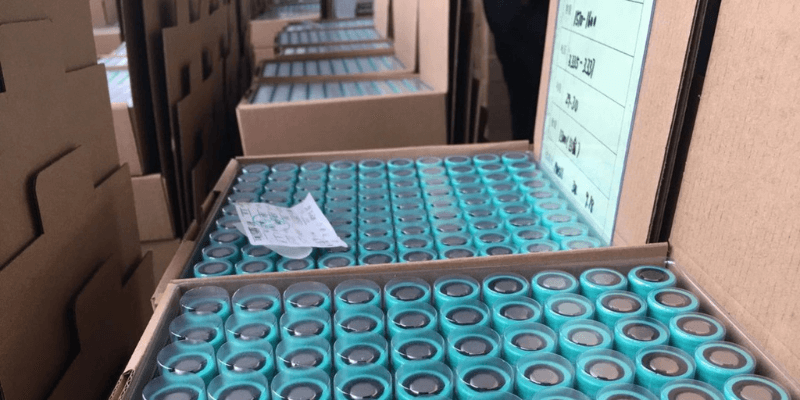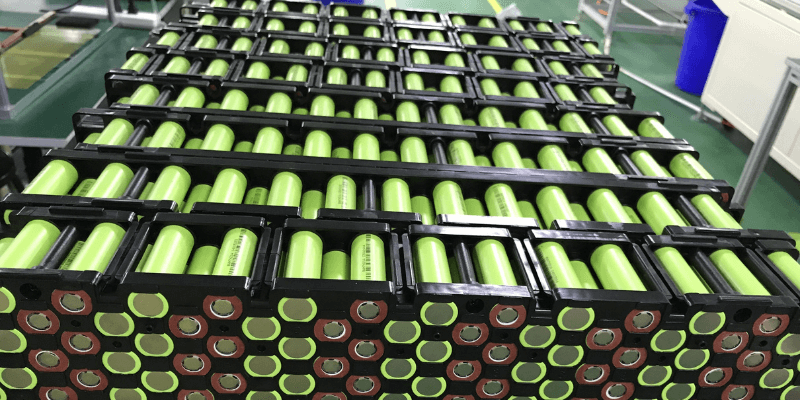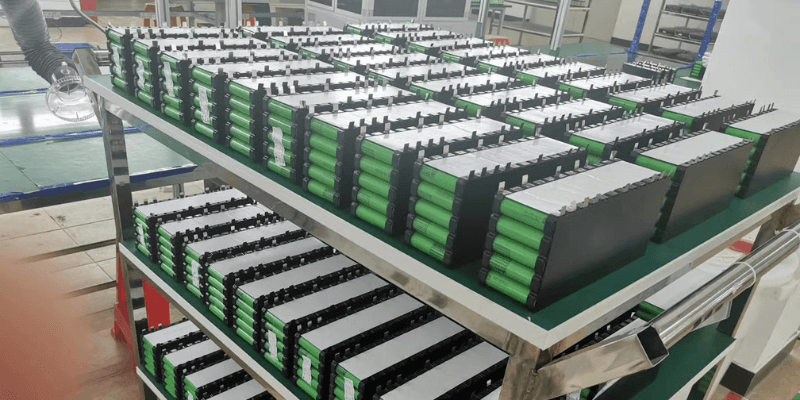Key Takeaway:
- Manufacturing custom lithium-ion battery packs requires precise engineering, quality control, and safety standards. The process involves gathering requirements, selecting cells, concurrent engineering, prototyping, certification, production planning, and lifecycle support.
Developing custom battery solutions requires extensive expertise across electrical, mechanical, and quality engineering. While off-the-shelf lithium packs may not fully meet an application’s specific power, energy, size, or functionality needs, a custom pack built to unique requirements provides an optimized solution.
However, the process for designing, certifying, and manufacturing specialized lithium-ion packs differs greatly from standard options. In the following content, we’ll explore each manufacturing step at a technical level, including:
- Critical process controls to ensure consistency
- Techniques to maximize performance within constraints
- Methods to verify pack quality and reliability
- Safety protocols when dealing with lithium-ion cells
- Industry regulations governing lithium battery production
Let’s examine how our expert engineering teams approach building custom lithium-ion battery packs tailored for the most demanding applications.
Key Phases in Custom Pack Manufacturing
Our major phases in developing and producing custom lithium-ion battery packs include:
- Initial requirements gathering and design
- In-depth cell selection and sourcing
- Electrical and mechanical engineering
- Prototyping design validation
- Safety testing and certification
- Production planning and process development
- Cell fabrication with strict process controls
- Precision battery assembly fixtures and automation
- Rigorous quality inspections throughout manufacturing
- Installation support and pack lifespan monitoring
Next, we’ll explore each phase in detail, including technical considerations unique to manufacturing custom battery solutions.
Defining Product Requirements
Thoroughly capturing custom lithium battery requirements in a product requirements document (PRD) is imperative for engineering teams to properly design an optimized solution. Key parameters that must be defined include:
Electrical
- Required capacity, energy density and voltage
- Peak current and power for maximum load
- Target internal impedance and resistance
- Operating temperature ranges and thermal dissipation needs
- Charging characteristics – constant current, multi-stage etc.
Mechanical
- Weight and size limitations
- Mounting points, frames, and clearances
- Enclosure material selections
- Environmental sealing needs and ingress protection (IP) rating
- Vibration, shock, crush resistance requirements
Functional
- Estimated cycle and calendar lifetime at defined DOD
- Idle self-discharge rate limits
- Required communication interfaces and data logging
- Any additional sensors or electronics needed
Quality & Program
- Target defect rates and margin of error
- Mandatory certifications like UL 1642 or UN 38.3
- Budgetary constraints and cost ceilings
- Schedule expectations and milestones
Careful requirements gathering prevents late-stage design changes.
Selecting High Performance Lithium-Ion Cells
The foundation of any custom lithium-ion battery pack lies in the selection of the integrated cells. Our cell selection for custom packs involves:
- Determining optimal lithium-ion cell chemistry – nickel manganese cobalt (NMC), lithium iron phosphate (LFP), etc.
- Evaluating available cell formats – cylindrical, pouch, or prismatic
- Checking cell capability, quality track record, and production capacity
- Sourcing cylindrical and laminate cell samples from vendors for head-to-head testing if needed
- Comparing cell performance benchmarks – energy density, specific power, cycle life, safety
- Finalizing the cell optimizing key trade offs – cost, power delivery, lifespan, form factor
Lithium-ion cell advancements continue expanding performance boundaries yearly. Leveraging state-of-the-art cell technology is crucial for maximizing custom pack capabilities.

Electrical and Mechanical Engineering
Concurrent electrical and mechanical engineering is needed to optimize the custom pack design within constraints.
Electrical Engineering
- Designing bus bar geometries and connection methods to achieve required current capacity and minimize resistance
- Wiring harnesses routing to enable manufacturability and serviceability
- Fuse and battery relay sizing to provide fault protection up to pack maximum current
- Thermistor placements and quantities for fine-grained temperature monitoring
- Optimizing sensor and communications interfaces to required peripherals
Mechanical Engineering
- Enclosure material selection balancing cost, strength, weight, and manufacturability
- Internal component spacing allowing sufficient airflow for thermal management
- Mounting points, frames, braces for required structural rigidity
- Cell retainer, harness, and fastener design preventing shock or vibration damage
- Interconnection methods – welding, soldering, mechanical fastening
- Modeling thermals to develop cooling channels, heat spreaders, and insulation
The marriage of electrical and mechanical engineering is essential to avoid sub-optimal tradeoffs in custom battery design.
Design Validation through Prototyping
Building and evaluating multiple design prototypes is a must for custom lithium battery development. Prototyping allows:
- Testing mechanical form and fit using 3D printed enclosures
- Confirming electrical performance meets requirements
- Validating thermal management maintains cell temperatures
- Refining BMS sensor placements, controls, and algorithms
- Qualifying vibration resistance with shaker table testing
- Verifying design safety via failure mode and effect analysis
- Improving manufacturability based on assembly evaluations
Repeated prototyping uncovers flaws not apparent during computer-aided engineering.
Mandatory Safety Certifications
Acquiring safety and regulatory certifications verifies pack compliance:
- UL 1642 – Critical certification for lithium-ion battery safety from Underwriters Laboratories
- IEC 62133 – International standard specifying safety requirements for portable sealed secondary cells
- UN 38.3 – UN testing methodology for safe transport of lithium batteries
- CE Marking – Confirms conformity with European health, safety, and environmental standards
- FCC – Validates electromagnetic compatibility and interference limits
- RoHS – European Union Restriction of Hazardous Substances directive
Testing is performed by accredited laboratories who issue formal certifications after requirements are met.
Production Planning and Process Refinement
Meticulous front-end planning prevents unforced errors during manufacturing:
- Creating comprehensive bills of materials specifying approved vendors and parts
- Designing assembly fixtures, jigs, and tools for error-proof production
- Defining automated and manual test stations needed for process control
- Developing detailed operator assembly and test instructions
- Analyzing manufacturing sites for space, power, environmental, and safety needs
- Planning supply chain logistics for components and cell inventory
- Recruiting and training competent cell fabrication and pack assembly technicians
- Instituting statistical process controls tracking key performance metrics
Thoughtful process planning translates to quality outcomes.
Rigorous Quality Control Steps
Consistent quality is verified through inspections before, during, and after production:
Incoming Quality Control (IQC) – Ensures raw materials and components meet specifications
- Inspecting incoming lithium-ion cells – verifying capacities, voltage profiles, and grading
- Checking plates, foils, separators before cell fabrication
- Testing printed circuit board lots for defects
- Validating pack parts like housings and connectors
In-Process Quality Control (IPQC) – Maintains process capability and stability
- Statistical process control (SPC) tracking critical parameters
- Defect counts, sampling rates, and continuous improvement
- Cell and pack inspection at each assembly step
- Process audits ensuring procedures are followed
Final Product Quality Control (FPQC) – Confirms pack quality before shipment
- Dimensional inspection against drawings
- Testing pack capacity, internal resistance and temperature rise
- X-ray inspection of internal connections
- Validate construction meets design – thermals, clearances etc.
- Run functional tests under load to verify performance
Robust quality control is crucial for establishing process repeatability and eliminating defects.

Lithium-Ion Cell Fabrication
Producing prismatic or pouch lithium-ion cells with the consistency required for pack assembly mandates tightly controlled environments and processes. Cell fabrication steps include:
- Mixing – Formulating cathode and anode slurries with stringent composition control
- Coating – Uniformly applying electrode coatings to current collector foils
- Calendering – Precisely adjusting electrode coating thickness
- Slitting – Cutting electrode sheets into specific widths
- Winding/Stacking – Winding cylindrical or stacking layered electrodes with separator
- Tab welding – Welding cell terminals along electrode edges
- Electrolyte filling – Injecting formulated liquid electrolyte into cell
- Formation – Initial charge-discharge cycle activating electrodes
- Aging – Breaking-in and stabilizing cells before testing
- Grading – Grouping cells into bins by tested capacity, impedance, and voltage profile
Maintaining process capability delivers the cell consistency vital for pack assembly. Small cell variations compound when multiplied by thousands in a pack.
Battery Pack Assembly Process
Assembling cells and components into a ruggedized battery pack requires meticulous construction:
- Matching cells by grade for minimal variation
- Electrically interconnecting cells in series via welding or fasteners
- Securing cells in custom fixtures during pack assembly
- Routing and securing high voltage wiring harnesses
- Mounting and thermally interfacing power electronics boards
- Applying thermal interface material between cells
- Attaching bus bars with exact torque specifications
- Integrating components into metal or plastic enclosures
- Conformal coating boards for environmental protection
- Potting assemblies with epoxy or silicone for structural rigidity
- Torque auditing fasteners during process to verify assembly integrity
Each production step must adhere to strictly defined processes and acceptance criteria to guarantee reliable end products.
Installation, Operation, and Lifecycle Considerations
Once produced, properly supporting packs throughout service life is paramount:
- Providing detailed installation best practices to integrate packs correctly
- Onboard data logging monitoring usage, warning flags, and fault codes
- Analyzing field data to continuously improve future designs
- Delivering firmware updates to expand capabilities and fix bugs
- Offering repair, reconditioning or recycling services for expired packs
- Proactively circulating safety information on proper handling, risks, and precautions
This lifecycle mindset maximizes the ROI of custom lithium-ion battery investments.
Lithium-Ion Battery Safety Considerations
Working with lithium-ion cells and batteries necessitates rigorous safety protocols given flammability risks if improperly handled. Key manufacturing precautions include:
- Passivating electrode scrap and spent cells in sand bins before disposal
- Delimiting designated lithium storage areas with fireproof cabinets and suppression
- Enforcing personal protective equipment like gloves, goggles, and flame-resistant clothing
- Avoiding cell charging near flammable materials or vapors
- Only using non-conductive tools designed for lithium battery assembly
- Prohibiting jewelry or loose clothing near moving machinery
- Training cell fabrication and pack assembly staff on lithium battery safety
Strict adherence to lithium-ion safety practices protects personnel and facilities.

By approaching specialized lithium-ion battery development as a cross-functional engineering challenge requiring rigorous validation, companies can successfully build custom packs unlocking unique performance capabilities.
Related Articles:

